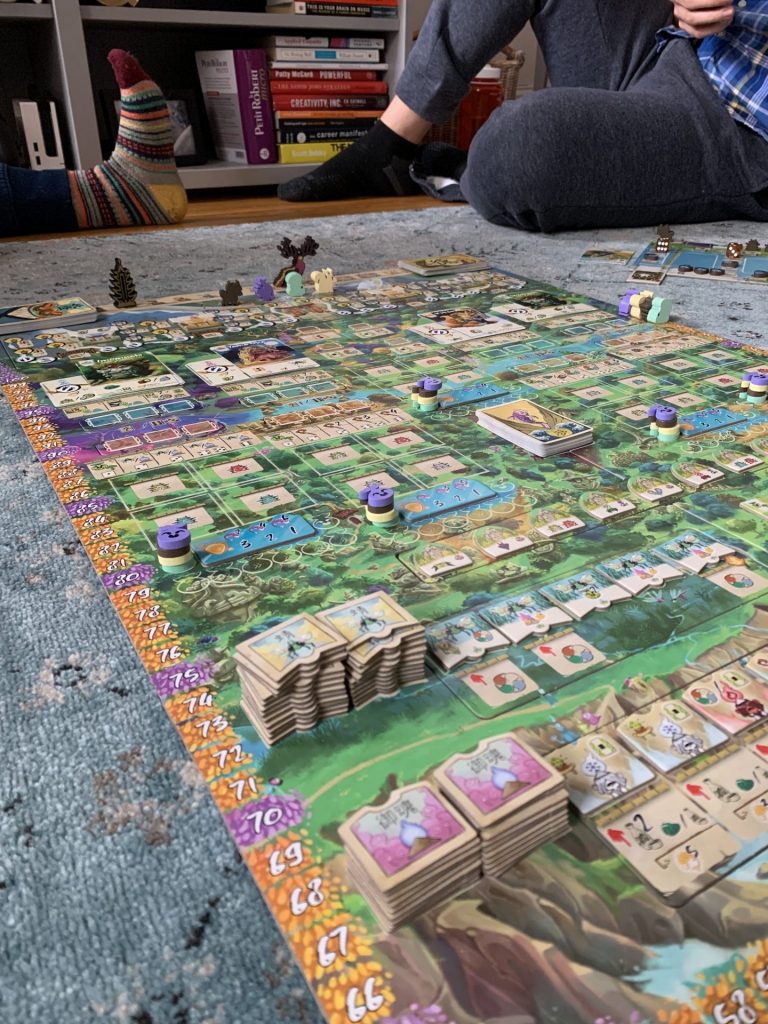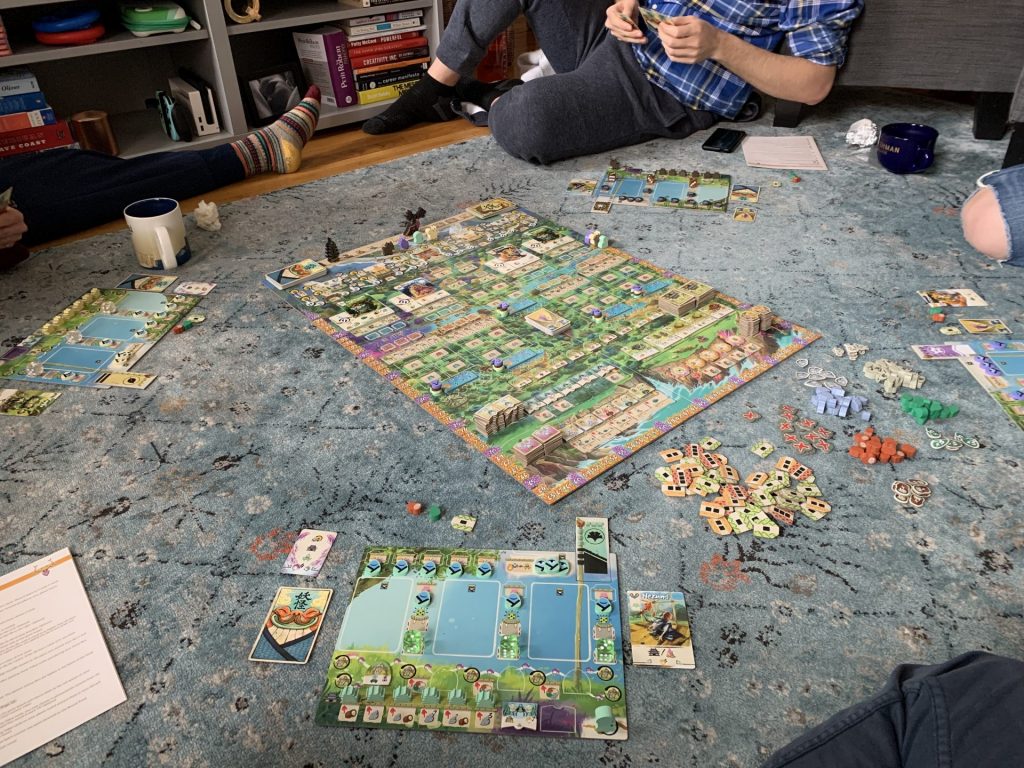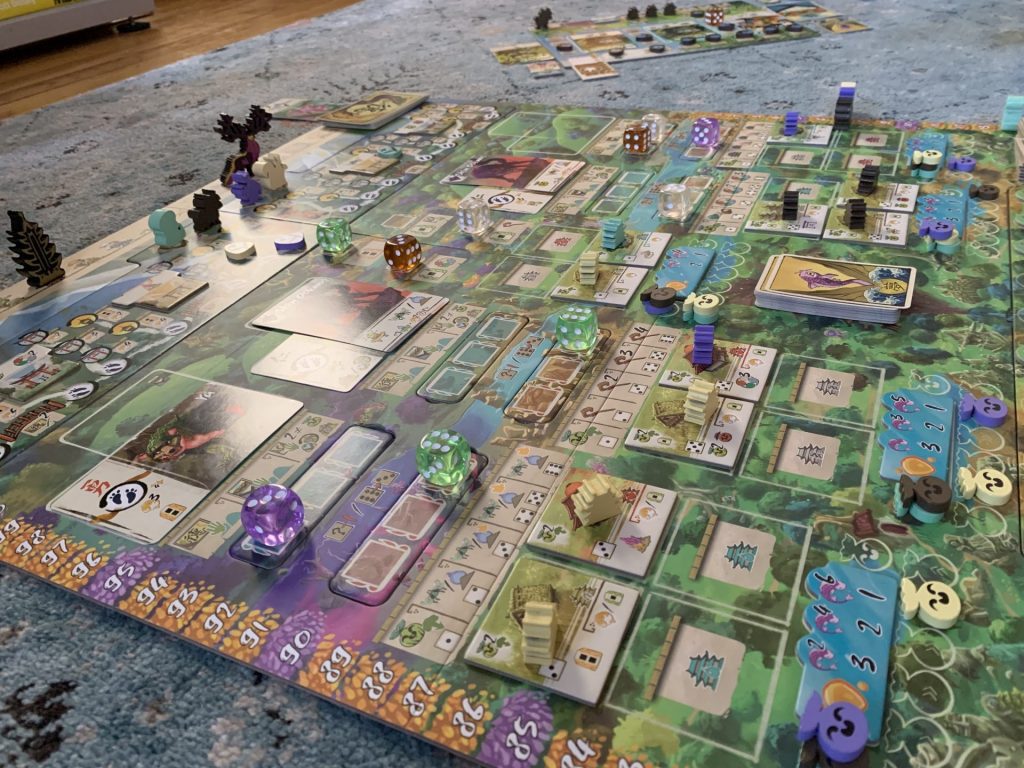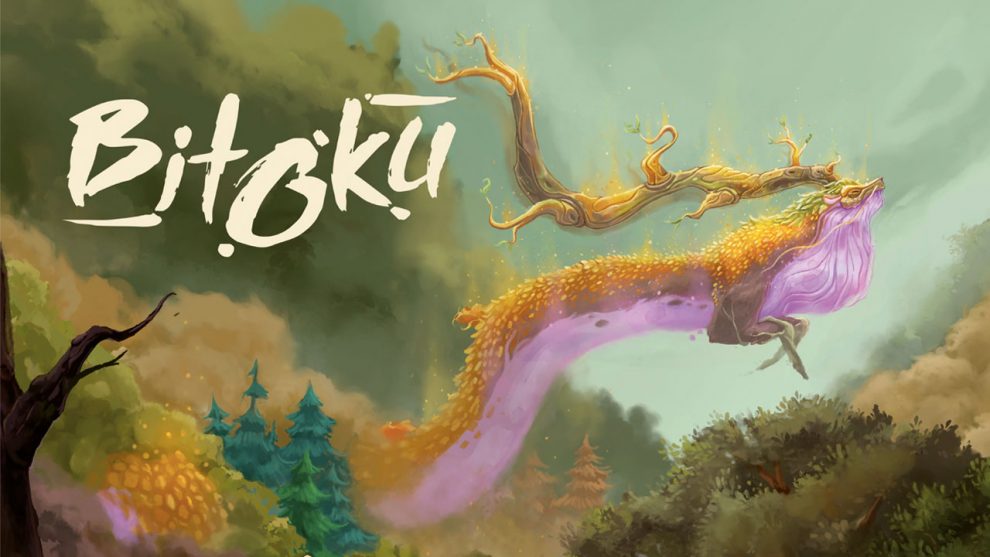Disclosure: Meeple Mountain received a free copy of this product in exchange for an honest, unbiased review. This review is not intended to be an endorsement.
Bitoku is a new, mid-to-heavy Euro game from Devir, the Spanish publisher responsible for The Red Cathedral and LUNA Capital. Devir has started to make a name for itself by packaging deep games in shallow boxes, as noble a mission as can be, and releasing games with high quality production.
The theme is great: Following years of speculation and rumor, the Great Spirit has finally announced their retirement from presiding over the Japanese forest. You, a spirit defined by your shrewd opportunism, sense a promotion. In the four years that remain before the great spirit moves on—always polite to give proper notice—you will conspire to accrue the most influence amongst the forest’s lesser spirits in an attempt to claim the top job for yourself.

An Overview
I’m not sure how to explain Bitoku to you. There only seem to be two choices: too cursory, or too detailed. This is a quirk of Bitoku’s structure, which is an overlapping mesh of a dozen or so mechanics. The manual is 26 packed pages, not including the section on solo rules. If I started going through everything, this review would end up being 2,000 words and I would be very tired.
The fundamentals of game play, the actions that are directly available to you on your turn, are straightforward. You either play a Youkai card to your player board, place an unlocked Guardian die onto one of the Forest spaces, or have a previously placed Guardian cross the river, which decreases its strength but gives you access to powerful action spaces. When you can’t do any of those things anymore, or do not wish to, you pass.
There are restrictions on Guardian placement that increase player interactivity. In order to use a forest space that already has an occupant, your Guardian’s value must meet or exceed the other Guardian’s. Additionally, the powerful actions across the river are first come, first served. From time to time, play falls into an elegant dance as everyone navigates the timing of these actions.
The game becomes more inscrutable when you consider the plethora of indirect actions that are available. If I have counted correctly, there are sixteen (16) indirect actions available to you as a result of those three (3) direct actions. They boil down to Using Movement Points (2 different places you can use those), Gaining a Card (4 different kinds of cards), Gaining a Token (6 different kinds of tokens), Placing a Pilgrim, Gaining Resources, Drawing a Card, and Moving a Kodama, one of five tokens you have spread across five different miniature race tracks.
Many of the indirect actions provide yet further indirect actions as a reward. As convoluted as this sounds, the interaction of the mechanisms is impressively smooth once you internalize the iconography. One step leads gracefully to the next, which leads to the next. From a design standpoint, both in terms of the game and the graphics, it’s very well done. It’s a nightmare to play with people who get analysis paralysis, but it is well done.
More Like Bits-Toku
As you can imagine, an ungodly—so to speak—number of components are in this box. Tiles of all shapes and sizes. The first setup was so unexpectedly involved that I was too tired to play afterwards. This does improve. Prior to the third play, which was with repeat players and following a concentrated effort to work out the best system for storing everything in the included baggies, getting Bitoku out of the box and onto the table in a semi-reasonable amount of time was analogous to and as satisfying as a finely-tuned NASCAR pit stop. Mind, that means it did take a full team of people who knew what was going on.
Once setup is done, Bitoku looks great on the table, assuming yours is big enough. Mine, which measures 60” x 31.5”, a table which has successfully and without contortion hosted full Thanksgiving dinners for six or seven people, is not big enough for more than two players. At three or four, we have to play on the floor. The central board’s footprint combined with the space needed for player boards is substantial.
 Without wanting to sound like I’m contradicting myself, Bitoku is also one of the more impressively space-efficient games I’ve ever played. It couldn’t take up less space without being substantially redesigned. You would have to remove entire mechanisms. The tokens and various tracks are about as jam-packed as possible. The board walks a tightrope of legibility, occasionally wavering just a bit too much.
Without wanting to sound like I’m contradicting myself, Bitoku is also one of the more impressively space-efficient games I’ve ever played. It couldn’t take up less space without being substantially redesigned. You would have to remove entire mechanisms. The tokens and various tracks are about as jam-packed as possible. The board walks a tightrope of legibility, occasionally wavering just a bit too much.
Big Games Need Love Too. No Discriminating Here Squirrel.
I’m convinced that the scope of the game is not to Bitoku’s benefit, and I say that for a few reasons.
- I cannot be bothered to play again because I cannot be bothered to set it up, and I cannot be bothered to teach it. It simply takes too long. At first, my play group was inclined to blame the setup time on the lack of any sort of insert. With reflection, though, while an insert would be welcome, I’m really not sure it would solve the issue. The team at Devir has minimized setup as much as possible. The board is modular, and uses reversible slats to adjust the number of market spaces for the number of players, so at least you don’t have to dig out all the tokens marked 3+ or 4+ to get setup done. I commend that unusual and utilitarian choice. Still. A nightmare.
- The size of the board and the number of pieces might scare away a lot of the people who would probably like this game. Once you get into the flow of it, Bitoku is downright breezy. Once you figure out which parts of the board to tune out, you’ll discover that Bitoku is medium weight strategy tied to heavy weight component quantity. People who want to feel like they’re playing a heavy game without actually playing one are the people most likely to end up loving what Bitoku is selling. With this many components and this long of a teach, they are not gonna make it through the door.
- I could get in a session of a much meatier game in the same amount of play time, with no change in the amount of psychological wear to the players. If I’ve got four people together and everyone is down to learn a heavier two-hour game, Bitoku is never going to be my suggestion. I’d rather introduce them to Pax Pamir or El Grande or Orléans. The teach would take just as long, if not less time, and the gameplay is significantly more rewarding, even on the first play.

I’m just not exactly sure who Bitoku is for, I guess. It’s too involved for casual board gamers, but it doesn’t have the depth needed to keep the True Believers around. After two and a half games, I felt like I’d pretty much solved it. The premise is wonderful, but it doesn’t come through in the gameplay at all. The story might as well be “The forest spirit asks you and three other lesser spirits to play this abstract board game together, and the winner is the person with the most points.”
I would never say Bitoku is bad. As a feat of both graphic and board game design, it’s downright impressive. That all of these moving pieces work together as smoothly as they do is remarkable. The central mechanic, releasing and placing and moving your three Guardians, can create these wonderful instances of subtle pacing and interactivity. That’s exactly the sort of thing that I love in a game, but those moments are fleeting. Most of the time, Bitoku feels like a game that has replaced quality of decision with quantity of options.












Add Comment